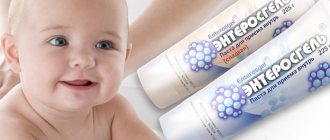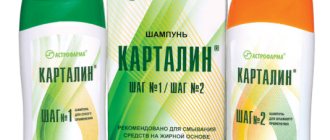Ointments for diathesis are divided into hormonal and hormone-free. The first group includes products with glucocorticosteroids: Elokom, Advantan, Celestoderm and Sinaflan. They have a powerful anti-inflammatory effect, acting directly on the synthesis of pro-inflammatory elements. Non-hormonal drugs can be prescribed to children from an early age, as they contain safe essential oils, moisturizing components or histamine receptor blockers (they do not have a systemic effect on the body).
Treatment of diathesis
Diathesis is a skin disease that often occurs in young children. It manifests itself as dry skin, itching and redness. To treat it, hormonal and non-hormonal agents should be used.
The most effective drugs of the first group are:
| Product name | approximate cost |
| Elokom | 200-500 rubles |
| Advantan | 500-1200 rubles |
| Celestoderm | 250-400 rubles |
| Sinaflan | 50-150 rubles |
Additionally, when using hormonal ointments, enterosorbents should be used, which have an antiallergic effect. These products include Polysorb and Enterosgel. In some cases, antihistamines (for example, Suprastin) should be used, since the development of diathesis is caused by allergens - dust particles, pollen, pet hair, powder and cosmetics with fragrances.
Non-hormonal drugs are used to treat young children. The most effective include:
| Product name | approximate cost | |
| Bepanten | 300-500 rubles (depending on the volume of the tube of cream or ointment) | |
| Fenistil | 340-620 rubles | |
| Elidel | 900-1500 rubles | |
| Emolium | 500-2000 rubles | |
Elokom
Elokom is produced in the form of lotion, cream and ointment. The main component is mometasone, which is a synthetic hormone. It has an anti-inflammatory effect by inhibiting the release of cytokines and leukotrienes. As a result, after applying the cream, inflammation, swelling and hyperemia disappear in patients. When used topically, mometasone does not penetrate into the blood and does not have a systemic effect.

The drug is prescribed to children over 2 years of age for the treatment of diathesis and other inflammatory diseases of the body. The only contraindication is intolerance to mometasone, which manifests itself as itching and pain after applying the product to the skin.
For the treatment of diathesis, cream and ointment should be applied once a day, covering the affected areas with a thin layer. The lotion is used to treat long-term pathologies that are complicated by weeping. It is a solution that must also be applied once a day to the affected areas. Using a cotton pad, rub Elokom until completely absorbed. The course of treatment is 4-5 weeks, after which you need to see a doctor for a re-examination.
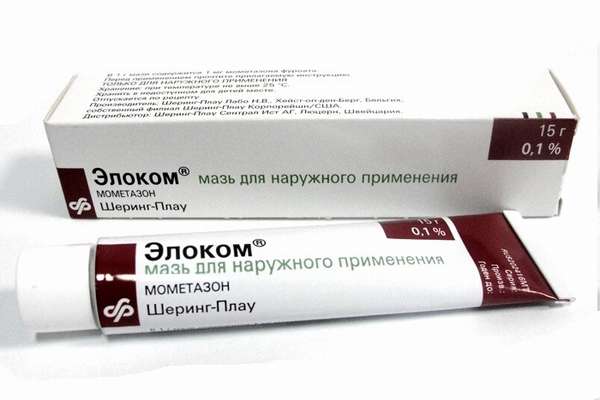
During pregnancy and breastfeeding, the medicine is used only if safer means are ineffective. Adverse reactions occur with prolonged use of cream and lotion. They are characterized by signs of skin atrophy - thinning, the appearance of a vascular pattern on the surface of the body and the development of purulent complications. This is due to the fact that glucocorticosteroids act as immunosuppressants, reducing the body’s protective function.
Rules for the use of creams and ointments for allergies in a child
The most important rule is to contact a specialist, especially for allergies in infants. Self-medication is fraught with various complications, for example, you can confuse infectious dermatitis with an allergy and carry out completely incorrect treatment. The doctor will be able to conduct a full diagnosis, rule out similar diseases, as well as prescribe treatment and give recommendations on it.
Medicines must be used in accordance with the instructions ; if the doctor has prescribed other dosages, then follow his recommendations. Most drugs are applied in a thin layer. Before applying, you need to thoroughly clean the area; after the procedure, do not wash off the ointment for some time.
If there is no progress in treatment, the ointment is changed to another or the diagnosis is clarified, but the therapeutic effect may not occur due to the continued exposure of the child to the allergen, in which case it will be necessary to get rid of the suspected allergy triggers one by one.
Since the child may not be aware of the consequences, care must be taken to ensure that the applied medicine does not get inside, as well as into the eyes and mucous membranes. Each ointment has side effects, if they begin to appear, you need to urgently see a doctor. Side effects are treated symptomatically. If deterioration and a severe allergic reaction begin, the medicine should be washed off quickly.
Advantan
Advantan is available in the form of fatty and non-fat ointment, emulsion and cream. They contain methylprednisolone. It also refers to synthetic glucocorticosteroids that have a pronounced anti-inflammatory effect. Advantan reduces the production of inflammatory cells, which contribute to the formation of swelling and itching in the skin. After using the cream, patients lose pain and flaking on the surface of the body. A distinctive feature of the drug is that even with long-term use (more than 6 weeks), a group of people did not experience the development of thinning and atrophy of the epidermis.

The ointment is used for the treatment of allergic dermatitis, eczema, burns and dermatosis. The emulsion helps get rid of eczema caused by various microbes (staphylococci, streptococci, pneumococci, etc.). The product should not be used in patients with signs of severe skin infections (tuberculosis, syphilis, chickenpox, rubella, measles), within 2-3 days after administration of the vaccine, in children under 4 months of age and with intolerance to methylprednisolone.
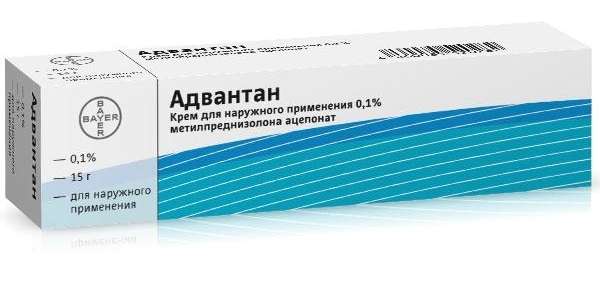
To treat diathesis, Advantan should be applied in a thin layer to the body only once a day. Within 1 minute, the medicine is completely absorbed and does not form an unpleasant film on the skin and does not give a feeling of tightness. The cream or ointment should be used for 1-2 months for adults; children under 1 year of age are not recommended to use the medicine for more than 4 weeks. The emulsion is used for the treatment of severe dermatoses lasting no more than 14 days.

Advantan is sometimes used in pregnant and breastfeeding women. In this case, its use should be agreed with a gynecologist. Adverse reactions appear in the form of a rash, which is small in size and does not rise above the skin.
Celestoderm
Celestoderm is produced in the form of cream and ointment in various concentrations. The drug contains betamethasone and a broad-spectrum antibiotic, gentamicin. Betamethasone is a modern glucocorticosteroid that provokes fewer adverse reactions with long-term use and is not addictive. Gentamicin affects most pathogens that begin to multiply on the skin after the immunosuppressive effects of hormones.
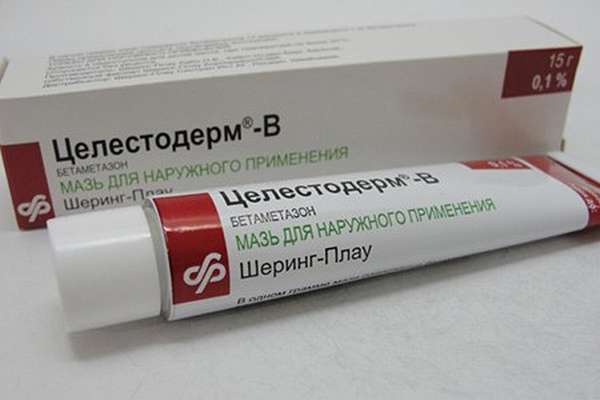
The cream is used for the treatment of eczema and diathesis of any etiology, seborrhea, dryness, peeling and psoriasis. Celestoderm effectively copes with diaper rash in children and itching in the elderly. The drug should not be used by patients with viral pathology (chickenpox, rubella, herpes, mononucleosis), cancer, during breastfeeding and pregnancy.
Celestoderm should not be used in children on large areas of skin (abdomen, back), since gentamicin can penetrate into the vascular bloodstream. Contraindications are the age of the child under six months and damage to the mucous membranes in the area where the product is applied.
Celestoderm is used only for external use on the skin. To do this, distribute the cream evenly over the affected areas twice a day. Treatment should be continued for 1-2 weeks, depending on the severity of clinical manifestations. With prolonged use, fungal diseases (candidiasis, thrush) and prickly heat may develop.
Sinaflan
Sinaflan is produced in the form of ointments of various concentrations. The main active ingredient is fluocinolone, which is an effective synthetic hormone. It reduces the synthesis of prostaglandins from arachidonic acid, which leads to a decrease in inflammation and itching. Patients also experience a disappearance of redness of the skin, which is associated with impaired immune defense.
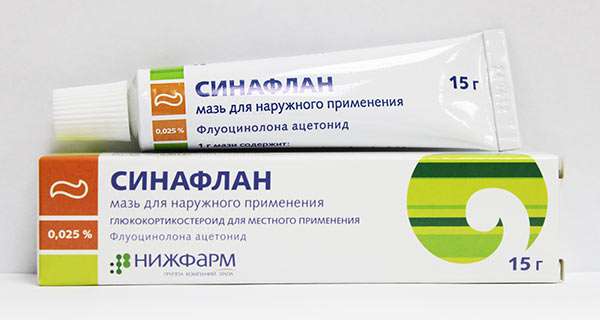
The drug has an antiallergic effect, which is achieved by reducing the amount of cytokines and mast cells at the site of inflammation. Glucocorticosteroids have a positive effect on the vascular wall, leading to its thickening. The ointment is prescribed for the treatment of psoriasis, diathesis and eczema of any etiology. Do not use the medicine during pregnancy, fungal and bacterial skin diseases (tuberculosis, thrush), herpes, chickenpox and on skin areas with an open wound surface.
It is recommended for adults to use Sinaflan 3 times a day with a break of 8 hours, and for children - up to 2 times a day. The duration of therapy can be from 10 to 20 days, depending on the clinical manifestations. The exact number of days of treatment is determined by the doctor. Adverse reactions include atrophic changes, which occur in extremely rare cases.
Causes
The body’s tendency to develop skin reactions develops in the following cases:
- constant exposure to stress;
- excess of spicy, fried, fatty foods in the diet, addiction to meat dishes, lack of fresh fruits and vegetables;
- smoking, alcohol abuse;
- lack of sleep, improper daily routine, poor diet;
- infectious diseases;
- chronic pathologies;
- weakened immunity.
Diathesis in adults ICD code – 10 – L20 – L30 “Dermatitis and eczema”.
Bepanten
Bepanthen is produced by a German pharmaceutical company in the form of a cream and ointment. The products contain several components: dexapanthenol, alcohol, lanolin, propylene glycol. Bepanten is for external use only. Its main property is to improve skin nutrition processes and accelerate its regeneration.
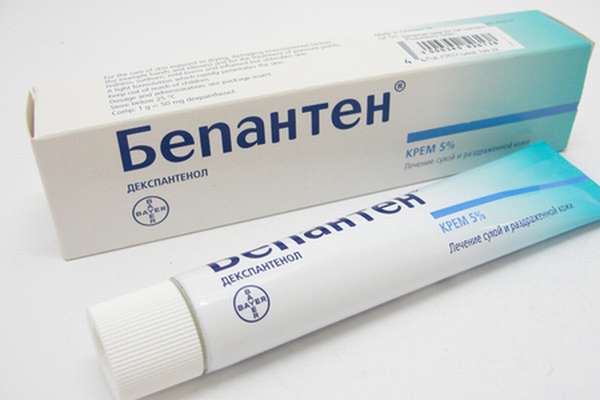
Dexapanthenol is the main component of the cream, which, after penetration into the epidermis, is converted under the action of local enzymes and acids into pantothenic acid. It contains coenzyme A, a natural skin regeneration factor that enhances the production of connective tissue fibers. Dexapanthenol accelerates metabolic processes in the deep layers of the skin. It is prescribed for the treatment of many diseases, including diathesis.
Bepanten should never be applied to the skin of a child or adult who is allergic to any of the components of the product. For the treatment of children, it is recommended to use the medicine every 10-12 hours for 1-2 months. Adults should use the product daily for several months, applying the cream to the affected areas of the skin every 6-8 hours. Bepanten is not addictive and is suitable for the treatment of diathesis in the groin area (when wearing diapers) and in natural folds (in summer).
The cream is safe during pregnancy and breastfeeding. Adverse reactions are very rare and include itching and flaking.
Types and forms of the disease
Doctors identify several types of diathesis in adults:
- hemorrhagic diathesis. Dangerous disease: even a slight impact on the epidermis provokes bleeding and hematomas;
- allergic. The problem arises when the body is hypersensitive to the action of food components, paints, varnishes, house dust, saliva and animal hair, and other irritants;
- neuro-arthritic. Rashes on the body occur against the background of a disturbance in the emotional state. Increased excitability at the slightest negative news, anxiety, sudden mood swings are the causes of unpleasant skin reactions;
- lymphatic-hypoplastic. Dryness, irritation, and rashes on the skin appear against the background of damage to the mucous membranes with reduced immunity, frequent viral and bacterial infections.
Learn about the symptoms of a bleach allergy and how to treat the condition.
Instructions for using calcium chloride for allergies are described on this page.
Fenistil
Fenistil is produced in the form of a transparent gel and emulsion, the main substance of which is dimethindene. It belongs to antiallergic drugs that block specific histamine receptors. After applying the product, the patient feels a quick pain relief effect that lasts for several hours.
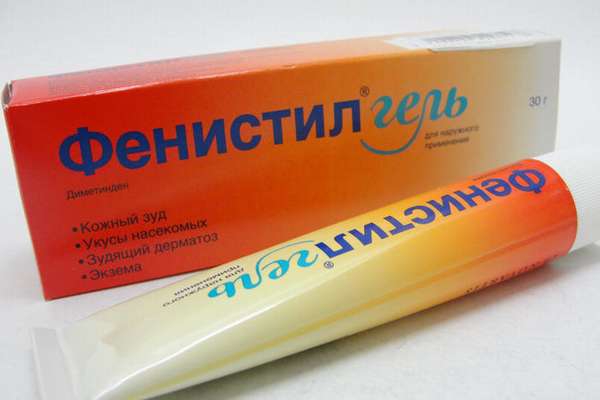
Dimetindene acts on the wall of small capillaries, increasing their permeability, which helps reduce the inflammatory reaction and reduces redness. Fenistil is a symptomatic drug, that is, it does not affect the cause of the development of itching or redness, but only reduces the clinical manifestations of the disease. The emulsion additionally cools and freezes the body area.
Fenistil is used to treat burns, dermatitis and itching caused by any reason (insect bites, allergies, injections, etc.). The product should not be used in infants in the first months of life, with bronchial asthma, increased intraocular pressure and in the early stages of pregnancy.
The gel should be applied pointwise, in a small layer to the affected area. You need to use it up to 3-4 times a day, depending on the cause of the disease. The average duration of treatment is 5 days. The emulsion is applied every 6 hours and is recommended for larger affected areas.
If used incorrectly, burning and itching of the skin, rash or dry areas of the body may occur. Cases of overdose have never been reported.
Elidel
Elidel is available in the form of a cream of varying volumes, which contains pimecrolimus. It belongs to antihistamines - this is a special group of drugs that blocks the release of histamine from destroyed mast cells. Pimecrolimus binds to histamine receptors and prevents the development of the clinical picture of allergies: itching, inflammation, swelling, hyperemia, and so on. Additionally, Elidel affects the immune system, in particular t-lymphocytes (they provide the main protection). The product reduces their production and prevents the formation of boils or pyoderma.

Diathesis ointment is used to treat dermatitis of allergic etiology and dermatoses in children caused by exposure to chemicals (powders, powders, emulsions). Avoid contact of the cream with the skin of infants under 3 months of age if they are intolerant to pimecrolimus. Elidel is also contraindicated for children with viral pathologies on the skin (herpes, chickenpox, rubella), high fever, mycotic complications and other pathologies.
With extreme caution, the product is prescribed to patients with Netherton's disease, since in this case the absorption of the main component of the cream into the systemic bloodstream increases. As a result, the entire body is affected, which can provoke the development of extensive adverse reactions.
Elidel is recommended to be applied to the affected skin twice a day for 2-3 weeks. Rub the product until it is completely absorbed; you can use a cotton swab for this.
Adverse reactions include burning or pain at the site of application. Rarely, suppuration occurs and a secondary infection (virus, fungus) occurs. With prolonged use, persons with an allergic predisposition may develop anaphylactic shock, the treatment of which will require emergency hospitalization or calling a medical team.
Complications. Anaphylactic shock. Quincke's edema
Quincke's edema
Allergic swelling of the mucous membranes can develop in various organs, but laryngeal edema, which occurs in a fifth of patients, is the most dangerous because it leads to difficulty breathing. Its symptoms: pale or bluish skin, shortness of breath. When examining the oral cavity, swelling is noticeable. If help is not provided in time, the patient may die from suffocation.
Anaphylactic shock
An acute allergic reaction that develops rapidly, within a few minutes. It is characterized by inhibition of a number of vital functions, in particular, a drop in pressure. Emergency medical attention required.
Urgent medical care for anaphylactic shock or Quincke's edema
At home, before the emergency medical team arrives, you can help a patient with anaphylactic shock or Quincke's edema by administering an ampoule of adrenaline. Therefore, it is recommended to store sterile syringes and an adrenaline ampoule in your home medicine cabinet.



